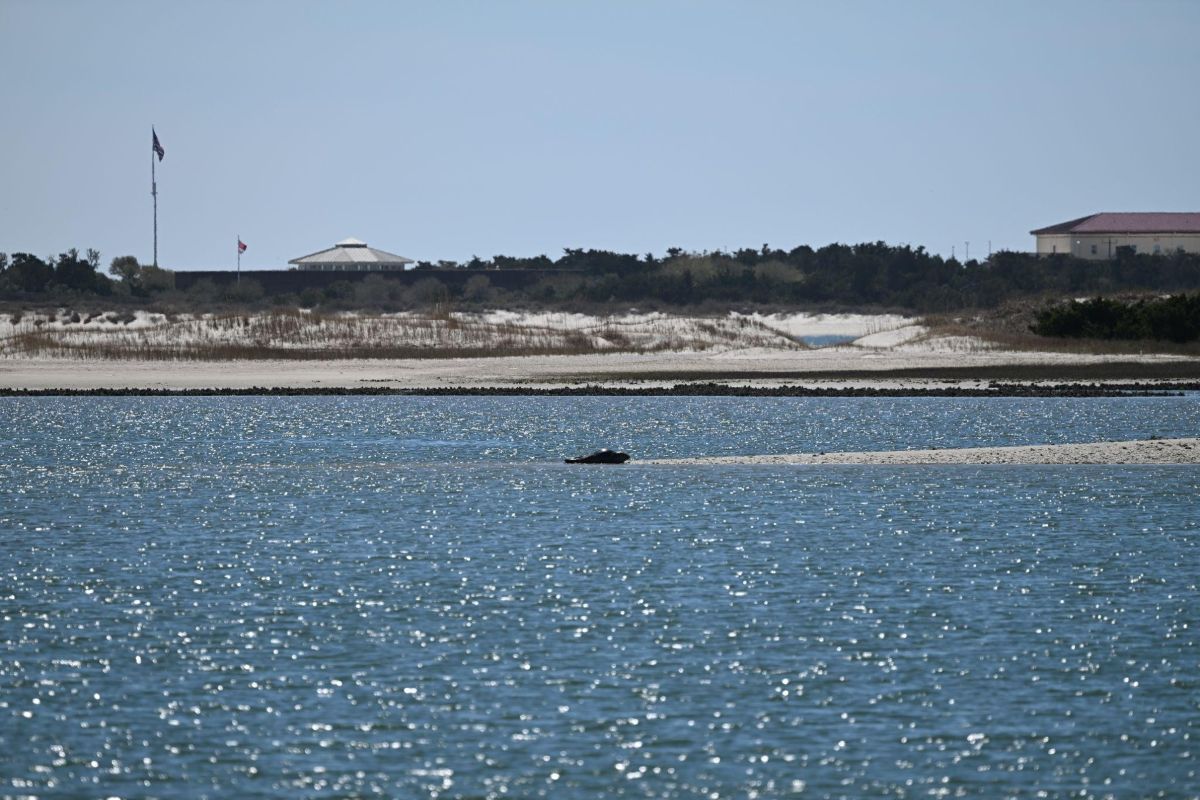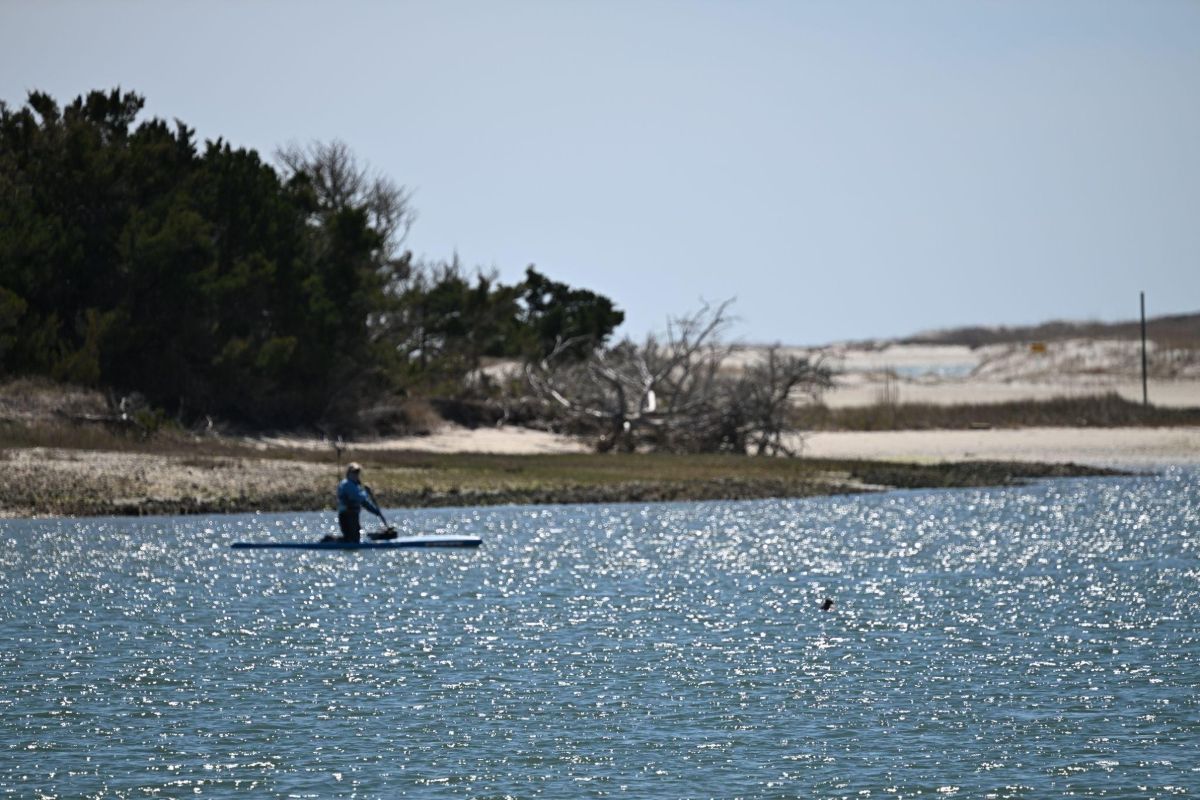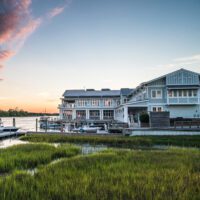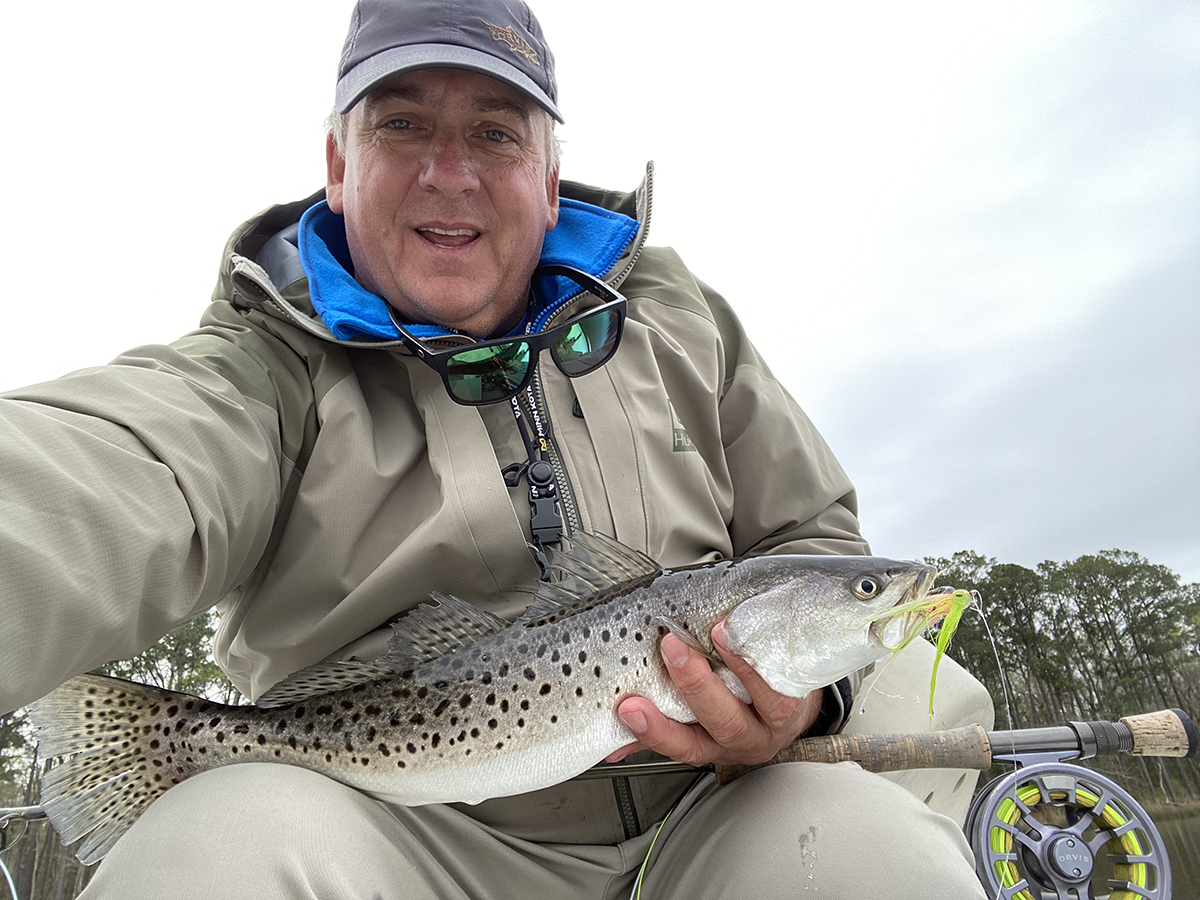
A gaggle of excited students and staff stand at the seawall, peering across the Beaufort Channel. Chatter ebbs and flows as people come up with possible explanations of what they’re seeing. Is it a sea turtle? A log? A lump of plastic? Finally, the silhouette moves, revealing its true identity. Excitement rushes through the crowd — it’s definitely a seal!
While commonplace in the Northeast, this seal was 600 miles south of Boston in Beaufort, North Carolina. The animal, a harbor seal, was repeatedly sighted in the Beaufort area the week of March 24, swimming in Taylors Creek and hauling out at the Rachel Carson Reserve.
Supporter Spotlight
Miriam Sutton, owner and director of Science by the Sea Eco-Tours, heard about the seal and set off on her paddleboard to catch a glimpse. She knew the seal was in the area but didn’t know it was so close. Sutton turned around and, “it just kind of caught me off guard,” she said.

Ava Kocher, a sophomore at the Duke University Marine Lab, was part of the gathering that spotted the seal from the seawall. “It was a time where I wished I could have walked on water so I just could have gotten a little closer,” Kocher said.
Luckily, Brantley Acree, chief mate aboard the Marine Lab’s R/V Shearwater, pulled up to the seawall in a skiff and offered to take students closer to the seal. Mindful to keep at least 50 meters, or 164 feet, between themselves and the seal, students took photos of the seal and noted its behavior.
The seal was big news. “There was a lot of talk from the people who had been at the Marine Lab for so long, for so many years, and had never seen one, that if they hadn’t seen one in all of their time here, there must be something wrong with this one and you must be like a penguin in the North Pole, seriously lost,” Kocher said.
Sutton has lived in the Beaufort area for 31 years and had yet to see a seal. “That’s the first one I’ve actually seen … certainly not this far south,” she said.
Supporter Spotlight
Originally from Massachusetts, Kocher noticed a big difference in how people talk about seals here. “I’ve seen so many harbor seals, and when you see them on Cape Cod, you’re not even excited about the seals. You’re thinking about, ‘Oh, there’s seals on the beach. There must be sharks in the water’ … And so then to go from that to here in North Carolina, where that harbor seal is so much more rare and of an occurrence, then that suddenly was a huge anomaly.”
“It was exciting to see that something that was commonplace in one region of the world could be groundbreaking or indicative of a pattern in another place, and it just feels like you’re not learning what’s going on in the world. Because if the world is always changing, there’s always something new to be learned,” Kocher said.

While seals are rarer in North Carolina than in Massachusetts, this one wanderer is closer to an established harbor seal colony than you might think. Harbor seals have been hauling out in Oregon Inlet, on the Outer Banks, for at least 10 years.
As for when the Outer Banks population first popped up, “we don’t know a lot about its origins and when harbor seals were first seen regularly there,” said Dr. Andy Read, Stephen A. Toth Professor of Marine Biology, director of the Duke University Marine Lab and co-author of a scientific article about the Oregon Inlet harbor seal population.
Read said we’re likely to see more harbor seals in this area “because the population of harbor seals has been protected since 1972 as the result of the Marine Mammal Protection Act and has been protected largely in Canada now, but also as a result of habitat exclusion by gray seals, which were also recovering and maybe squeezing harbor seals out of their former range.”
Seals may have been in the area historically. A harbor seal specimen from the North Carolina Museum was found in Ocracoke Inlet in the 1930s, and there is some evidence that they’ve been seen in the intervening decades.
Read is one of the leaders of a Duke Bass Connections Team that will attempt to dig into this in the next academic year. The team of doctoral, master’s and undergraduate students will pore through stranding records, newspaper articles, archeological information, scientific literature and other sources to reconstruct the timeline of harbor seal abundance in North Carolina.
Dr. Vicky Thayer, the North Carolina Aquarium’s Marine Mammal Stranding coordinator and adjunct professor for North Carolina State College of Veterinary Medicine, has gotten many calls about seals in the area over the years. North Carolina has the highest diversity of any state in the country when it comes to strandings and sightings of marine mammals with four species of seals, 35 species of cetaceans, and manatees reported stranded or seen off of the coast.
“We get the northern limit of the tropical species and the southern limit of that temperate species. And it’s such an exciting place to work. We learn so much from stranded specimens. We never know what species, will wash ashore next,” Thayer said.
Thayer received numerous calls about the recent harbor seal in the Beaufort area. Procedure dictates that the stranding team gives seals for 24 hours before responding because they need to haul out and rest.
“As long as the seal is resting in a place that seems that people will not harass it or obstruct its access to the water,” Thayer said, “then we attempt to educate people and let them know that observing from a distance is fine. We post volunteers and set up a perimeter if the seal is in a heavily trafficked area.”
On March 28, Jillian Daly of Beaufort was kayaking in Taylors Creek after work when she saw a “large gray lump” in the marsh.
“I’d heard there was a seal hanging around the Rachel Carson Reserve, so I quickly realized that’s what I was seeing,” Daly said, “I zoomed in with my camera and saw bile pooled around it’s open mouth, a cut under its neck, and noticed it didn’t seem to be breathing.”
It was the same seal, now dead.
Daly reached out to Thayer and with her location and photos of the seal.
“It was so sad,” Daly said, “I’ve never seen a seal in Beaufort and I wish I’d seen it alive and well. However, I’m glad I was able to locate it before animals or other folks came across it so Vicky could retrieve it and perform a necropsy.”
Thayer, N.C. Aquarium Veterinarian Dr. Emily Christiansen, and Bonehenge Whale Center Director Keith Rittmaster were able to recover the seal that night and perform a necropsy, an animal autopsy, a few days later.
The initial necropsy report found that the animal was a thin out-of-habitat subadult harbor seal. The seal had a cataract in its left eye, lesions on its tongue, and was missing a tooth, all of which may have made foraging difficult. There were also parasites in its stomach, intestines, lungs, and airways, which also could have contributed to its thin condition.
Even though there’s now a colony in North Carolina, this seal is still considered a straggler, out of its habitat. “The weather here isn’t really great for them …The climate is too warm and getting warmer, and so it’s not a good option for long term survival, for high numbers,” said Thayer.
“The climate is shifting and the prey and the population numbers are changing, and so that’s causing species to expand their ranges, maybe, and it’s not always good for long term survival of individuals.”
We might never know why this seal was down in Beaufort, adding yet another question to the long list of things we don’t know about seals in North Carolina. “What are they doing here? What are they eating? How long are they staying? What’s their body condition? Like, what age and sex classes are here? Are they interacting with human activities like fisheries?” Read asked.
Harbor seals are a conservation success story; they beat the odds and recovered from extirpation across their range. But without answers to these questions, the perception of seals might not be so positive. However, the unknown is also exciting; there’s so much left to discover.
If you see a seal in North Carolina, stay at least 50 yards away. “The seals need to rest, and you shouldn’t obstruct their path to the water and stay away from them, because they carry diseases and they can bite,” Thayer said. Please call 252-241-5119 to report live and dead seals and manatees, and stranded whales, dolphins, and porpoises.
“If they’re not stressed, they can fight off disease better. People approaching them can stress them, and if they are sick, but might be able to recover with rest. People may be preventing their recovery by approaching them too closely and they carry diseases that can be transmitted to humans and dogs,” said Thayer.
Thayer and Read both expect to see an increase in the number of seals in the Beaufort area in the future. Only time will tell if this lone seal was a random occurrence or a harbinger of the future.







